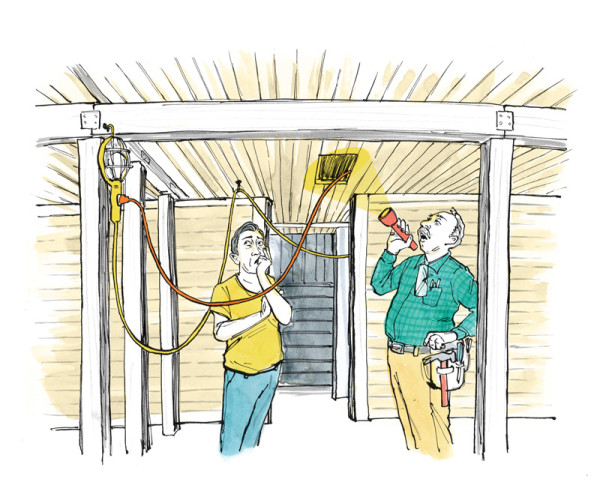(Illustration: Brett Affrunti)
“Our apartment is in a 19th-century brick row house. During kitchen renovation, we discovered that our old electric stove was plugged into an orange utility cord. Our contractor traced the cord to a boarded-up utility space three floors below. When he broke into it, he found the cord plugged into a “trouble” light, still plugged directly into the electrical box. Forget frying eggs on that stove—we could have burned to a crisp!” —Ken Mayne
The Fix
Taking shortcuts with electricity is usually a recipe for disaster. Whoever set up your range did several things wrong: using an extension cord in place of permanent wiring, and connecting the cord to another temporary power source, the trouble light, which compounded the first mistake.
Extension cords usually come with plug attachments at both ends, so it can be tempting to use one as a temporary source of power when the electricity is turned off in a living space. The problem arises when the “temporary” solution becomes permanent, as it did in your home. This kind of thing is not only illegal, it’s downright dangerous.
According to the National Electric Code (NEC), extension cords—regardless of gauge or rating—should never be used as a substitute for permanent wiring. They are not designed for continuous use and may deteriorate rapidly if they are left plugged in. Cords snaked through ceilings or through holes in walls are unable to vent heat. Both conditions can lead to electrical fires.
Appliances are designed to draw electricity from flexible power supply cords. To be safe, they must draw energy from properly installed electrical outlets. Use of extension cords as a substitute for fixed wiring is a recognized fire hazard, according to the NEC.
The solution, of course, is to have proper electrical wiring installed by a competent licensed electrician. At a minimum, this means installing a new electrical outlet to accommodate the new appliance (with either three or four prongs, depending on the range), plus a dedicated circuit in the electrical box.







